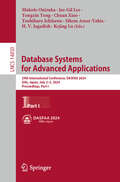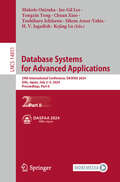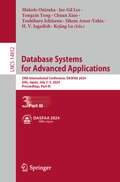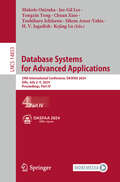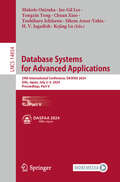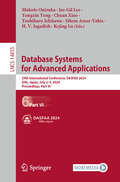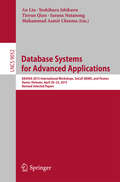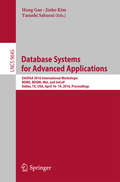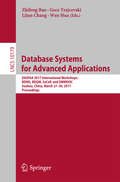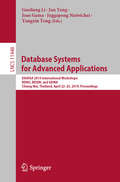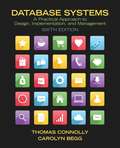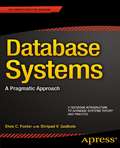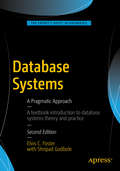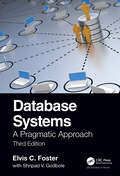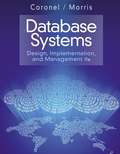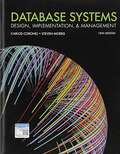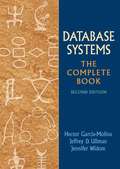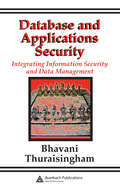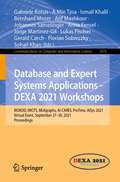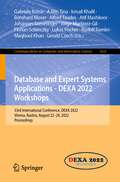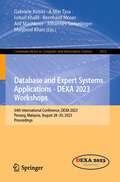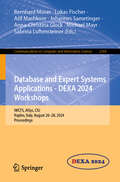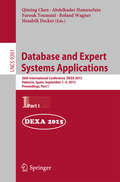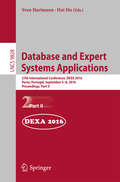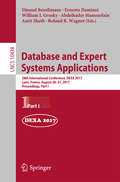- Table View
- List View
Database Systems for Advanced Applications: 29th International Conference, DASFAA 2024, Gifu, Japan, July 2–5, 2024, Proceedings, Part I (Lecture Notes in Computer Science #14850)
by Yoshiharu Ishikawa Yongxin Tong Jae-Gil Lee Chuan Xiao Sihem Amer-Yahia Makoto Onizuka H. V. Jagadish Kejing LuThe seven-volume set LNCS 14850-14856 constitutes the proceedings of the 29th International Conference on Database Systems for Advanced Applications, DASFAA 2024, held in Gifu, Japan, in July 2024. The total of 147 full papers, along with 85 short papers, presented together in this seven-volume set was carefully reviewed and selected from 722 submissions. Additionally, 14 industrial papers, 18 demo papers and 6 tutorials are included. The conference presents papers on subjects such as: Part I: Spatial and temporal data; database core technology; federated learning. Part II: Machine learning; text processing. Part III: Recommendation; multi-media. Part IV: Privacy and security; knowledge base and graphs. Part V: Natural language processing; large language model; time series and stream data. Part VI: Graph and network; hardware acceleration. Part VII: Emerging application; industry papers; demo papers.
Database Systems for Advanced Applications: 29th International Conference, DASFAA 2024, Gifu, Japan, July 2–5, 2024, Proceedings, Part II (Lecture Notes in Computer Science #14851)
by Yoshiharu Ishikawa Yongxin Tong Jae-Gil Lee Chuan Xiao Sihem Amer-Yahia Makoto Onizuka H. V. Jagadish Kejing LuThe seven-volume set LNCS 14850-14856 constitutes the proceedings of the 29th International Conference on Database Systems for Advanced Applications, DASFAA 2024, held in Gifu, Japan, in July 2024. The total of 147 full papers, along with 85 short papers, presented together in this seven-volume set was carefully reviewed and selected from 722 submissions. Additionally, 14 industrial papers, 18 demo papers and 6 tutorials are included. The conference presents papers on subjects such as: Part I: Spatial and temporal data; database core technology; federated learning. Part II: Machine learning; text processing. Part III: Recommendation; multi-media. Part IV: Privacy and security; knowledge base and graphs. Part V: Natural language processing; large language model; time series and stream data. Part VI: Graph and network; hardware acceleration. Part VII: Emerging application; industry papers; demo papers.
Database Systems for Advanced Applications: 29th International Conference, DASFAA 2024, Gifu, Japan, July 2–5, 2024, Proceedings, Part III (Lecture Notes in Computer Science #14852)
by Yoshiharu Ishikawa Yongxin Tong Jae-Gil Lee Chuan Xiao Sihem Amer-Yahia Makoto Onizuka H. V. Jagadish Kejing LuThe seven-volume set LNCS 14850-14856 constitutes the proceedings of the 29th International Conference on Database Systems for Advanced Applications, DASFAA 2024, held in Gifu, Japan, in July 2024. The total of 147 full papers, along with 85 short papers, presented together in this seven-volume set was carefully reviewed and selected from 722 submissions. Additionally, 14 industrial papers, 18 demo papers and 6 tutorials are included. The conference presents papers on subjects such as: Part I: Spatial and temporal data; database core technology; federated learning. Part II: Machine learning; text processing. Part III: Recommendation; multi-media. Part IV: Privacy and security; knowledge base and graphs. Part V: Natural language processing; large language model; time series and stream data. Part VI: Graph and network; hardware acceleration. Part VII: Emerging application; industry papers; demo papers.
Database Systems for Advanced Applications: 29th International Conference, DASFAA 2024, Gifu, Japan, July 2–5, 2024, Proceedings, Part IV (Lecture Notes in Computer Science #14853)
by Yoshiharu Ishikawa Yongxin Tong Jae-Gil Lee Chuan Xiao Sihem Amer-Yahia Makoto Onizuka H. V. Jagadish Kejing LuThe seven-volume set LNCS 14850-14856 constitutes the proceedings of the 29th International Conference on Database Systems for Advanced Applications, DASFAA 2024, held in Gifu, Japan, in July 2024. The total of 147 full papers, along with 85 short papers, presented together in this seven-volume set was carefully reviewed and selected from 722 submissions. Additionally, 14 industrial papers, 18 demo papers and 6 tutorials are included. The conference presents papers on subjects such as: Part I: Spatial and temporal data; database core technology; federated learning. Part II: Machine learning; text processing. Part III: Recommendation; multi-media. Part IV: Privacy and security; knowledge base and graphs. Part V: Natural language processing; large language model; time series and stream data. Part VI: Graph and network; hardware acceleration. Part VII: Emerging application; industry papers; demo papers.
Database Systems for Advanced Applications: 29th International Conference, DASFAA 2024, Gifu, Japan, July 2–5, 2024, Proceedings, Part V (Lecture Notes in Computer Science #14854)
by Yoshiharu Ishikawa Yongxin Tong Jae-Gil Lee Chuan Xiao Sihem Amer-Yahia Makoto Onizuka H. V. Jagadish Kejing LuThe seven-volume set LNCS 14850-14856 constitutes the proceedings of the 29th International Conference on Database Systems for Advanced Applications, DASFAA 2024, held in Gifu, Japan, in July 2024. The total of 147 full papers, along with 85 short papers, presented together in this seven-volume set was carefully reviewed and selected from 722 submissions. Additionally, 14 industrial papers, 18 demo papers and 6 tutorials are included. The conference presents papers on subjects such as: Part I: Spatial and temporal data; database core technology; federated learning. Part II: Machine learning; text processing. Part III: Recommendation; multi-media. Part IV: Privacy and security; knowledge base and graphs. Part V: Natural language processing; large language model; time series and stream data. Part VI: Graph and network; hardware acceleration. Part VII: Emerging application; industry papers; demo papers.
Database Systems for Advanced Applications: 29th International Conference, DASFAA 2024, Gifu, Japan, July 2–5, 2024, Proceedings, Part VI (Lecture Notes in Computer Science #14855)
by Yoshiharu Ishikawa Yongxin Tong Jae-Gil Lee Chuan Xiao Sihem Amer-Yahia Makoto Onizuka H. V. Jagadish Kejing LuThe seven-volume set LNCS 14850-14856 constitutes the proceedings of the 29th International Conference on Database Systems for Advanced Applications, DASFAA 2024, held in Gifu, Japan, in July 2024. The total of 147 full papers, along with 85 short papers, presented together in this seven-volume set was carefully reviewed and selected from 722 submissions. Additionally, 14 industrial papers, 18 demo papers and 6 tutorials are included. The conference presents papers on subjects such as: Part I: Spatial and temporal data; database core technology; federated learning. Part II: Machine learning; text processing. Part III: Recommendation; multi-media. Part IV: Privacy and security; knowledge base and graphs. Part V: Natural language processing; large language model; time series and stream data. Part VI: Graph and network; hardware acceleration. Part VII: Emerging application; industry papers; demo papers.
Database Systems for Advanced Applications: DASFAA 2015 International Workshops, SeCoP, BDMS, and Posters, Hanoi, Vietnam, April 20-23, 2015, Revised Selected Papers (Lecture Notes in Computer Science #9052)
by An Liu Yoshiharu Ishikawa Tieyun Qian Sarana Nutanong Muhammad Aamir CheemaDASFAA is an annual international database conference, located in the Asia-Pacific region,which show cases state-of-the-art R & D activities in databases-terms and their applications. It provides a forum for technical presentations and discussions among database researchers, developers and users from academia, business and industry. DASFAA 2015 the 20th in the series, was held during April 20-23, 2015 in Hanoi, Vietnam. In this year, we carefully selected two workshops, each focusing on specific research issues that contribute to the main themes of the DASFAA conference. This volume contains the final versions of papers accepted for the two workshops: Second International Workshop on Semantic Computing and Personalization (SeCoP 2015); Second International Workshop on Big Data Management and Service (BDMS 2015); and a Poster Session. [All the workshops were selected via a public call-for-proposals process. The workshop organizers put a tremendous amount of effort into soliciting and - lecting papers with a balance of high quality, new ideas and new applications. We asked all workshops to follow a rigid paper selection process, including the procedure to ensure that any Program Committee members are excluded from the paper review process of any paper they are involved with. A requirement about the overall paper acceptance rate of no more than 50% was also imposed on all the workshops. ]
Database Systems for Advanced Applications: DASFAA 2016 International Workshops: BDMS, BDQM, MoI, and SeCoP, Dallas, TX, USA, April 16-19, 2016, Proceedings (Lecture Notes in Computer Science #9645)
by Jinho Kim Hong Gao Yasushi SakuraiThis book constitutes the workshop proceedings of the 21st International Conference on Database Systems for Advanced Applications, DASFAA 2016, held in Dallas, TX, USA, in April 2016. The volume contains 32 full papers (selected from 43 submissions) from 4 workshops, each focusing on a specific area that contributes to the main themes of DASFAA 2016: The Third International Workshop on Semantic Computing and Personalization, SeCoP 2016; the Third International Workshop on Big Data Management and Service, BDMS 2016; the First International Workshop on Big Data Quality Management, BDQM 2016; and the Second International Workshop on Mobile of Internet, MoI 2016.
Database Systems for Advanced Applications: DASFAA 2017 International Workshops: BDMS, BDQM, SeCoP, and DMMOOC, Suzhou, China, March 27-30, 2017, Proceedings (Lecture Notes in Computer Science #10179)
by Wen Hua Lijun Chang Zhifeng Bao Goce TrajcevskiThis two volume set LNCS 10177 and 10178 constitutes the refereed proceedings of the 22nd International Conference on Database Systems for Advanced Applications, DASFAA 2017, held in Suzhou, China, in March 2017. The 73 full papers, 9 industry papers, 4 demo papers and 3 tutorials were carefully selected from a total of 300 submissions. The papers are organized around the following topics: semantic web and knowledge management; indexing and distributed systems; network embedding; trajectory and time series data processing; data mining; query processing and optimization; text mining; recommendation; security, privacy, senor and cloud; social network analytics; map matching and spatial keywords; query processing and optimization; search and information retrieval; string and sequence processing; stream date processing; graph and network data processing; spatial databases; real time data processing; big data; social networks and graphs.
Database Systems for Advanced Applications: DASFAA 2019 International Workshops: BDMS, BDQM, and GDMA, Chiang Mai, Thailand, April 22–25, 2019, Proceedings (Lecture Notes in Computer Science #11448)
by Jun Yang Yongxin Tong Guoliang Li Joao Gama Juggapong NatwichaiThis book constitutes the workshop proceedings of the 24th International Conference on Database Systems for Advanced Applications, DASFAA 2019, held in Chiang Mai, Thailand, in April 2019. The 14 full papers presented were carefully selected and reviewed from 26 submissions to the three following workshops: the 6th International Workshop on Big Data Management and Service, BDMS 2019; the 4th International Workshop on Big Data Quality Management, BDQM 2019; and the Third International Workshop on Graph Data Management and Analysis, GDMA 2019. This volume also includes the short papers, demo papers, and tutorial papers of the main conference DASFAA 2019.
Database Systems: A Practical Approach to Design, Implementation, and Management (6th Edition)
by Thomas Connolly Carolyn BeggDatabase Systems is ideal for a one- or two-term course in database management or database design in an undergraduate or graduate level course. With its comprehensive coverage, this book can also be used as a reference for IT professionals. This best-selling text introduces the theory behind databases in a concise yet comprehensive manner, providing database design methodology that can be used by both technical and non-technical readers. The methodology for relational Database Management Systems is presented in simple, step-by-step instructions in conjunction with a realistic worked example using three explicit phases--conceptual, logical, and physical database design. #65533; Teaching and Learning Experience This program presents a better teaching and learning experience-for you and your students. It provides: Database Design Methodology that can be Used by Both Technical and Non-technical Readers A Comprehensive Introduction to the Theory behind Databases A Clear Presentation that Supports Learning
Database Systems: A Pragmatic Approach
by Elvis C. Foster Shripad V. GodboleDatabase Systems: A Pragmatic Approach provides a comprehensive, yet concise introduction to database systems. It discusses the database as an essential component of a software system, as well as a valuable, mission critical corporate resource. The book is based on lecture notes that have been tested and proven over several years, with outstanding results. It also exemplifies mastery of the technique of combining and balancing theory with practice, to give students their best chance at success. Upholding his aim for brevity, comprehensive coverage, and relevance, author Elvis C. Foster's practical and methodical discussion style gets straight to the salient issues, and avoids unnecessary fluff as well as an overkill of theoretical calculations. The book discusses concepts, principles, design, implementation, and management issues of databases. Each chapter is organized systematically into brief, reader-friendly sections, with itemization of the important points to be remembered. It adopts a methodical and pragmatic approach to solving database systems problems. Diagrams and illustrations also sum up the salient points to enhance learning. Additionally, the book includes a number of Foster's original methodologies that add clarity and creativity to the database modeling and design experience while making a novel contribution to the discipline. Everything combines to make Database Systems: A Pragmatic Approach an excellent textbook for students, and an excellent resource on theory for the practitioner.
Database Systems: A Pragmatic Approach
by Elvis C. Foster Shripad GodboleDatabase Systems: A Pragmatic Approach is a classroom textbook for use by students who are learning about relational databases, and the professors who teach them. It discusses the database as an essential component of a software system, as well as a valuable, mission critical corporate resource. The book is based on lecture notes that have been tested and proven over several years, with outstanding results. It also exemplifies mastery of the technique of combining and balancing theory with practice, to give students their best chance at success. Upholding his aim for brevity, comprehensive coverage, and relevance, author Elvis C. Foster''s practical and methodical discussion style gets straight to the salient issues, and avoids unnecessary fluff as well as an overkill of theoretical calculations. The book discusses concepts, principles, design, implementation, and management issues of databases. Each chapter is organized systematically into brief, reader-friendly sections, with itemization of the important points to be remembered. It adopts a methodical and pragmatic approach to solving database systems problems. Diagrams and illustrations also sum up the salient points to enhance learning. Additionally, the book includes a number of Foster''s original methodologies that add clarity and creativity to the database modeling and design experience while making a novel contribution to the discipline. Everything combines to make Database Systems: A Pragmatic Approach an excellent textbook for students, and an excellent resource on theory for the practitioner. What you''ll learn Learn the relational model and the advantages it brings to software systems Design database schemas with integrity rules that ensure correctness of corporate data Query data using SQL in order to generate reports, charts, graphs, and other business results Learn what it means to be a database administrator, and why the profession is highly paid Become familiar with the common database brands, their similarities and distinctives Explore special topics such as tree-based data, hashing for fast access, distributed and object databases, and more Who this book is for Database Systems: A Pragmatic Approach is aimed at students who are studying database technology, who aspire to a career as a database administrator or designer. The book is particularly useful for professors teaching such students, and who are in need of an affordable textbook. Practicing database administrators and developers wanting to strengthen their theoretical grounding in their discipline may also find the book useful. Table of Contents Part I: Preliminary Topics 1. Introduction to Database Systems 2. The Database System Environment Part II: The Relational Database Model 3. The Relational Model 4. Integrity Rules and Normalization 5. Database Modeling and Design 6. Database User Interface Design 7. Relational Algebra 8. Relational Calculus 9. Relational System a Closer Look Part III: Structured Query Language 10. Overview of SQL 11. SQL Definition Statements 12. SQL Data Manipulation Statements 13. Logical Views and Security 14. The System Catalog 15. Some Limitations of SQL Part IV: Some Commonly Used DBMS Suites 16. Overview of Oracle 17. Overview of DB2 18. Overview of Microsoft SQL Server 19. Overview of Gupta Team Developer and MySQL 20. Overview of Borland Delphi Part V: Advanced Topics 21. Database Administration 22. Distributed Database Systems 23. Object Databases 24. Data Warehousing and Information Extraction 25. Web-Accessible Databases Part VI: Final Preparations 26. Sample Exercises and Examination Questions Part VII: Appendices A. Review of Trees B. Review of Hashing C. Review of Information Gathering Techniques
Database Systems: A Pragmatic Approach, 3rd edition
by Elvis C. Foster Shripad V. GodboleThis book provides a concise but comprehensive guide to the disciplines of database design, construction, implementation, and management. Based on the authors’ professional experience in the software engineering and IT industries before making a career switch to academia, the text stresses sound database design as a necessary precursor to successful development and administration of database systems. The discipline of database systems design and management is discussed within the context of the bigger picture of software engineering. Students are led to understand from the outset of the text that a database is a critical component of a software infrastructure, and that proper database design and management is integral to the success of a software system. Additionally, students are led to appreciate the huge value of a properly designed database to the success of a business enterprise. The text was written for three target audiences. It is suited for undergraduate students of computer science and related disciplines who are pursuing a course in database systems, graduate students who are pursuing an introductory course to database, and practicing software engineers and information technology (IT) professionals who need a quick reference on database design. Database Systems: A Pragmatic Approach, 3rd Edition discusses concepts, principles, design, implementation, and management issues related to database systems. Each chapter is organized into brief, reader-friendly, conversational sections with itemization of salient points to be remembered. This pragmatic approach includes adequate treatment of database theory and practice based on strategies that have been tested, proven, and refined over several years. Features of the third edition include: Short paragraphs that express the salient aspects of each subject Bullet points itemizing important points for easy memorization Fully revised and updated diagrams and figures to illustrate concepts to enhance the student’s understanding Real-world examples Original methodologies applicable to database design Step-by-step, student-friendly guidelines for solving generic database systems problems Opening chapter overviews and concluding chapter summaries Discussion of DBMS alternatives such as the Entity–Attributes–Value model, NoSQL databases, database-supporting frameworks, and other burgeoning database technologies A chapter with sample assignment questions and case studies This textbook may be used as a one-semester or two-semester course in database systems, augmented by a DBMS (preferably Oracle). After its usage, students will come away with a firm grasp of the design, development, implementation, and management of a database system.
Database Systems: Design, Implementation, and Management (Eleventh Edition)
by Steven Morris Carlos CoronelPractical and easy to understand, DATABASE SYSTEMS: DESIGN, IMPLEMENTATION, AND MANAGEMENT, Eleventh Edition, gives students a solid foundation in database design and implementation. Filled with visual aids such as diagrams, illustrations, and tables, this market-leading text provides in-depth coverage of database design, demonstrating that the key to successful database implementation is in proper design of databases to fit within a larger strategic view of the data environment. Renowned for its clear, straightforward writing style, this text provides students with an outstanding balance of theory and practice. The eleventh edition has been updated to include expanded relational algebra coverage, updated business vignettes showing the impact of database tech in the real world, updated coverage of cloud data services, expanded coverage of Big Data and related Hadoop technologies, SQL coverage expanded to include MySQL databases, and many other improvements! In addition, new review questions, problem sets, and cases have been added throughout the book so that students have multiple opportunities to test their understanding and develop real and useful design skills.
Database Systems: Design, Implementation, and Management (Mindtap Course List Series)
by Steven Morris Carlos CoronelDatabase skills are among the most in-demand IT skills today. Now you can gain a solid foundation in database design and implementation with the practical, easy-to-understand approach in the market-leading DATABASE SYSTEMS: DESIGN, IMPLEMENTATION, AND MANAGEMENT, 13E. <p><p>Diagrams, illustrations, and tables clarify in-depth coverage of database design. You learn the key to successful database implementation as you study how to properly design databases to fit within the larger strategic data environment. Clear, straightforward writing supports an outstanding balance of theory and practice with hands-on skills today's employers want. Revised SQL coverage offers more SQL examples and simpler explanations that focus on the areas most important for a database career. More coverage of Big Data Analytics and NoSQL, including related Hadoop technologies, now provides a stronger hands-on approach.
Database Systems: The Complete Book
by Jeffrey D. Ullman Hector Garcia-Molina Jennifer WidomDatabase Systems: The Complete Book is ideal for Database Systems and Database Design and Application courses offered at the junior, senior and graduate levels in Computer Science departments. A basic understanding of algebraic expressions and laws, logic, basic data structure, OOP concepts, and programming environments is implied. <p><p> Written by well-known computer scientists, this introduction to database systems offers a comprehensive approach, focusing on database design, database use, and implementation of database applications and database management systems. <p> The first half of the book provides in-depth coverage of databases from the point of view of the database designer, user, and application programmer. It covers the latest database standards SQL:1999, SQL/PSM, SQL/CLI, JDBC, ODL, and XML, with broader coverage of SQL than most other texts. The second half of the book provides in-depth coverage of databases from the point of view of the DBMS implementor. It focuses on storage structures, query processing, and transaction management. The book covers the main techniques in these areas with broader coverage of query optimization than most other texts, along with advanced topics including multidimensional and bitmap indexes, distributed transactions, and information integration techniques.
Database and Applications Security: Integrating Information Security and Data Management
by Bhavani ThuraisinghamThis is the first book to provide an in-depth coverage of all the developments, issues and challenges in secure databases and applications. It provides directions for data and application security, including securing emerging applications such as bioinformatics, stream information processing and peer-to-peer computing. Divided into eight sections,
Database and Expert Systems Applications - DEXA 2021 Workshops: BIOKDD, IWCFS, MLKgraphs, AI-CARES, ProTime, AISys 2021, Virtual Event, September 27–30, 2021, Proceedings (Communications in Computer and Information Science #1479)
by Ismail Khalil A Min Tjoa Atif Mashkoor Anna Fensel Johannes Sametinger Bernhard Moser Jorge Martinez-Gil Gabriele Kotsis Lukas Fischer Sohail Khan Gerald Czech Florian SobieczkyThis volume constitutes the refereed proceedings of the workshops held at the 32nd International Conference on Database and Expert Systems Applications, DEXA 2021, held in a virtual format in September 2021: The 12th International Workshop on Biological Knowledge Discovery from Data (BIOKDD 2021), the 5th International Workshop on Cyber-Security and Functional Safety in Cyber-Physical Systems (IWCFS 2021), the 3rd International Workshop on Machine Learning and Knowledge Graphs (MLKgraphs 2021), the 1st International Workshop on Artificial Intelligence for Clean, Affordable and Reliable Energy Supply (AI-CARES 2021), the 1st International Workshop on Time Ordered Data (ProTime2021), and the 1st International Workshop on AI System Engineering: Math, Modelling and Software (AISys2021). Due to the COVID-19 pandemic the conference and workshops were held virtually. The 23 papers were thoroughly reviewed and selected from 50 submissions, and discuss a range of topics including: knowledge discovery, biological data, cyber security, cyber-physical system, machine learning, knowledge graphs, information retriever, data base, and artificial intelligence.
Database and Expert Systems Applications - DEXA 2022 Workshops: 33rd International Conference, DEXA 2022, Vienna, Austria, August 22–24, 2022, Proceedings (Communications in Computer and Information Science #1633)
by Ismail Khalil A Min Tjoa Atif Mashkoor Johannes Sametinger Bernhard Moser Jorge Martinez-Gil Gabriele Kotsis Lukas Fischer Gerald Czech Florian Sobieczky Alfred Taudes Rudolf Ramler Maqbool KhanThis volume constitutes the refereed proceedings of the workshops held at the 33rd International Conference on Database and Expert Systems Applications, DEXA 2022, held in Vienna, Austria, in August 2022: The 6th International Workshop on Cyber-Security and Functional Safety in Cyber-Physical Systems (IWCFS 2022); 4th International Workshop on Machine Learning and Knowledge Graphs (MLKgraphs 2022); 2nd International Workshop on Time Ordered Data (ProTime2022); 2nd International Workshop on AI System Engineering: Math, Modelling and Software (AISys2022); 1st International Workshop on Distributed Ledgers and Related Technologies (DLRT2022); 1st International Workshop on Applied Research, Technology Transfer and Knowledge Exchange in Software and Data Science (ARTE2022). The 40 papers were thoroughly reviewed and selected from 62 submissions, and discuss a range of topics including: knowledge discovery, biological data, cyber security, cyber-physical system, machine learning, knowledge graphs, information retriever, data base, and artificial intelligence.
Database and Expert Systems Applications - DEXA 2023 Workshops: 34th International Conference, DEXA 2023, Penang, Malaysia, August 28–30, 2023, Proceedings (Communications in Computer and Information Science #1872)
by Ismail Khalil A Min Tjoa Atif Mashkoor Johannes Sametinger Bernhard Moser Gabriele Kotsis Maqbool KhanThis volume constitutes the refereed proceedings of the workshops held at the 34th International Conference on Database and Expert Systems Applications, DEXA 2023, held in Penang, Malaysia, in August 2023: The 7th International Workshop on Cyber-Security and Functional Safety in Cyber-Physical Systems, IWCFS 2023, and The 3rd International Workshop on AI System Engineering: Math, Modelling and Software, AISys2023. The 7 full papers and 3 short papers were thoroughly reviewed and selected from 20 submissions, and discuss a range of topics including: knowledge discovery, biological data, cyber security, cyber-physical system, machine learning, knowledge graphs, information retriever, data base, and artificial intelligence.
Database and Expert Systems Applications - DEXA 2024 Workshops: IWCFS, AISys, CIU, Naples, Italy, August 26–28, 2024, Proceedings (Communications in Computer and Information Science #2169)
by Atif Mashkoor Johannes Sametinger Bernhard Moser Lukas Fischer Anna-Christina Glock Michael Mayr Sabrina LuftensteinerThis volume constitutes the refereed proceedings of the workshops held at the 35th International Conference on Database and Expert Systems Applications, DEXA 2024, which took place in Naples, Italy, in August 2024. The papers included in this book stem from the following workshops: - 9th International Workshop on Cyber-Security and Functional Safety inCyber-Physical Systems (IWCFS 2024), - 4th International Workshop on AI SystemEngineering: Math, Modelling and Software (AISys 2024), - 2nd InternationalWorkshop on Certainty in Uncertainty: Exploring Probabilistic Approaches in AI (CIU2024) The 10 full papers and 5 short papers were thoroughly reviewed and selected from a total of 24 submissions. They were organized in topical sections as follows: Cyber-security and functional safety in cyber-physical systems; AI system engineering: math, modelling, and software; certainty in uncertainty: exploring probabilistic approaches in AI.
Database and Expert Systems Applications: 26th International Conference, DEXA 2015, Valencia, Spain, September 1-4, 2015, Proceedings, Part I (Lecture Notes in Computer Science #9261)
by Abdelkader Hameurlain Roland Wagner Hendrik Decker Farouk Toumani Qiming ChenThis two volume set LNCS 9261 and LNCS 9262 constitutes the refereed proceedings of the 26th International Conference on Database and Expert Systems Applications, DEXA 2015, held in Valencia, Spain, September 1-4, 2015. The 40 revised full papers presented together with 32 short papers, and 2 keynote talks, were carefully reviewed and selected from 125 submissions. The papers discuss a range of topics including: temporal, spatial and high dimensional databases; semantic Web and ontologies; modeling, linked open data; NoSQLm NewSQL, data integration; uncertain data and inconsistency tolerance; database system architecture; data mining, query processing and optimization; indexing and decision support systems; modeling, extraction, social networks; knowledge management and consistency; mobility, privacy and security; data streams, Web services; distributed, parallel and cloud databases; information retrieval; XML and semi-structured data; data partitioning, indexing; data mining, applications; WWW and databases; data management algorithms. These volumes also include accepted papers of the 8th International Conference on Data Management in Cloud, Grid and P2P Systems, Globe 2015, held in Valencia, Spain, September 2, 2015. The 8 full papers presented were carefully reviewed and selected from 13 submissions. The papers discuss a range of topics including: MapReduce framework: load balancing, optimization and classification; security, data privacy and consistency; query rewriting and streaming.
Database and Expert Systems Applications: 27th International Conference, DEXA 2016, Porto, Portugal, September 5-8, 2016, Proceedings, Part II (Lecture Notes in Computer Science #9828)
by Sven Hartmann Hui MaThis two volume set LNCS 9827 and LNCS 9828 constitutes the refereed proceedings of the 27th International Conference on Database and Expert Systems Applications, DEXA 2016, held in Porto, Portugal, September 2016. The 39 revised full papers presented together with 29 short papers were carefully reviewed and selected from 137 submissions. The papers discuss a range of topics including: Temporal, Spatial, and High Dimensional Databases; Data Mining; Authenticity, Privacy, Security, and Trust; Data Clustering; Distributed and Big Data Processing; Decision Support Systems, and Learning; Data Streams; Data Integration, and Interoperability; Semantic Web, and Data Semantics; Social Networks, and Network Analysis; Linked Data; Data Analysis; NoSQL, NewSQL; Multimedia Data; Personal Information Management; Semantic Web and Ontologies; Database and Information System Architectures; Query Answering and Optimization; Information Retrieval, and Keyword Search; Data Modelling, and Uncertainty.
Database and Expert Systems Applications: 28th International Conference, DEXA 2017, Lyon, France, August 28-31, 2017, Proceedings, Part I (Lecture Notes in Computer Science #10438)
by Djamal Benslimane, Ernesto Damiani, William I. Grosky, Abdelkader Hameurlain, Amit Sheth and Roland R. WagnerThis two volume set LNCS 10438 and LNCS 10439 constitutes the refereed proceedings of the 28th International Conference on Database and Expert Systems Applications, DEXA 2017, held in Lyon, France, August 2017. The 37 revised full papers presented together with 40 short papers were carefully reviewed and selected from 166 submissions. The papers discuss a range of topics including: Semantic Web and Semantics; Graph Matching; Data Modeling, Data Abstraction, and Uncertainty; Preferences and Query Optimization; Data Integration and RDF Matching; Security and Privacy; Web Search; Data Clustering; Top-K and Skyline Queries; Data Mining and Big Data; Service Computing; Continuous and Temporal Data, and Continuous Query Language; Text Processing and Semantic Search; Indexing and Concurrency Control Methods; Data Warehouse and Data Stream Warehouse; Data Mining and Machine Learning; Recommender Systems and Query Recommendation; Graph Algorithms; Semantic Clustering and Data Classification.
